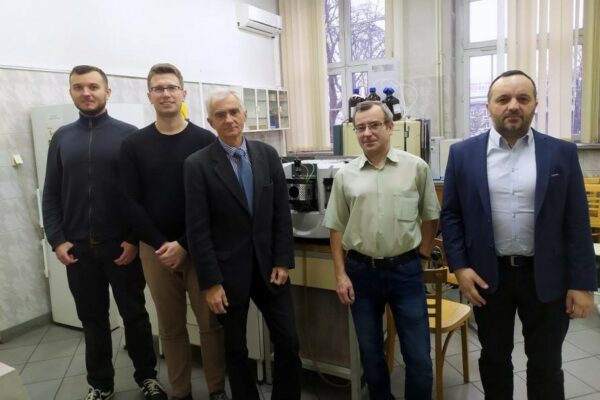RESEARCH EXCELLENCE INITIATIVE
FREEDOM OF RESEARCH – SCIENCE FOR THE FUTURE
“Freedom of Research – Science for the Future” series consists of articles, interviews and short videos presenting research conducted by the winners of the “Freedom of Research” call for proposals
Prof. Eng. Jarosław Polański
Big pharma must be a barracuda
| Author: Weronika Cygan-Adamczyk |
Since financing science in Poland is not and has never been a priority, our domestic research centres do not have as much influence as international giants. This does not mean at all—as assured by Prof. Eng. Jarosław Polański—that Polish researchers lack significant achievements. However, they have a harder time breaking through in the global scientific community, and the medical and materials industries are a good example of this.
“Drugs are effectively designed only in the most innovative centres, commonly referred to as big pharma, i.e. within the large pharmaceutical industry, which has at its disposal enormous funds. The public often feels outraged by this fact, but these largest companies earn so much that we perceive them as business barracudas. They have to be barracudas to be able to invest in new drugs”, explains Prof. Eng. Jarosław Polański, Director of the Centre for Materials and Drug Discovery at the University of Silesia. “The average cost of introducing one drug to the market can reach 2 billion dollars.”
Strict safety standards further complicate the process of drug design. Safety and environmental protection are non-negotiable for modern chemistry and industry. In general, however, the design of materials that, unlike drugs, are not administered to the human body, is subject to slightly fewer restrictions. This also means easier implementation, hence the Centre has recently focused on developing new materials, especially for energy and environmental catalysis. The methods for material design and testing, although generally cheaper than the analysis and design of drugs, pose a separate challenge. Typically, materials, unlike drugs, consist of a system of chemical compounds, including polymers.

From the left: Uladislau Zhdan, PhD student, Maciej Kapkowski, PhD, Prof. Eng. Jarosław Polański, Piotr Bartczak, PhD and Tomasz Siudyga, PhD, DSc, Assoc. Prof. | private archive
Healthier plants, less pollution
On the Centre’s website, one can find information that among the goals pursued by its members is the search for solutions that will meet standards in the field of environmental protection, combating climate change, as well as those related to the discovery of new sources and carriers of energy.
One of the latest projects that fit into these assumptions is the still ongoing ‘Design of key civilisation materials for energy and environmental nanocatalysis’—a project carried out as part of the Freedom of Research call for proposals within the Research Excellence Initiative at the University of Silesia. The programme enabled funding for research cooperation with employees of Côte d’Azur University in Nice, which resulted in several publications with Prof. Eng. J. Polański and other scientists from the Silesian university. Among them are not only chemists, but also materials engineers and representatives of other fields.
As part of the Lider grant managed by Maciej Kapkowski, PhD, an innovative product, AdiPlus, for use in agriculture was developed. It can be used as a penetrant increasing the efficiency of plant nutrition by reducing the dose of fertiliser by 20-25% and herbicides by 16-40%. The use of the preparation also allows for an increase in yields, in some cases reaching a boost of up to 24%. An additional benefit is the reduction of the negative impact on the natural environment due to the reduction in the amount of chemicals used, as well as the safe composition of AdiPlus itself. This also makes the use of the product more economical. Moreover, as assured by Prof. Eng. Jarosław Polański, it is six times cheaper than what is offered by other suppliers on the market.
Thanks to the project developed within the Freedom of Research call for proposals, scientists managed to create a compound that fits into the framework of sustainable technologies, safe for the environment. Limiting the harmfulness of fertilisers is one of the main postulates raised by international bodies and institutions around the world. “We should remember that fertilisers are not fully used by plants. What is not absorbed flows into rivers and seeps into the soil, posing a threat to other plants and animals, including humans”, the chemist says.
Nanocatalysis for the environment
The above-mentioned AdiPlus includes solutions that can be described as nanocatalysis for the environment. Thanks to it, it is possible to improve the efficiency of chemical reactions, making it easier to obtain or synthesise certain substances. As the Director of the Centre explains:
“Catalysts make it possible to reduce the amount of reagents, which means that we burden the environment with less waste. The catalyst can also work in more than one reaction cycle, in other words, it can be used multiple times. This significantly increases efficiency. Nanocatalysts are a specific type of catalysts. The prefix nano- means that at this scale substances acquire specific properties.”
The phenomenon of catalysis is also used in the management of carbon dioxide, so that it can be given new utility values and be used in energy processes, e.g. the combustion of the methane resulting from a catalytic reaction with hydrogen. Another direction could be the use of CO2 for synthesising reagents or even for storage itself. This energetic aspect is another area of interest for Prof. Eng. Jarosław Polański’s team.
“In such cases, catalytic methods are very useful. The process of burning coal produces not only carbon oxides, but also nitrogen oxides, among other things. These contaminants need to be removed from the combustion gases. They are reduced by ammonia produced in the process of urea decomposition. DeNOx catalysts are also produced using nanotechnological methods”, explains the scientist. The Centre has, among others, a patent for the regeneration of deNOx catalysts. These systems are designed to optimise the combustion process and reduce the emission of toxic compounds in power boilers used in power plants. The solution developed by the University of Silesia specialists makes the entire regeneration process more efficient, without requiring an increase in energy or operating costs.
Moreover, in this type of activities related to the production of technologies and materials, the team exchanges experiences with French researchers in developing new catalysis methods. Processes developed for drug production can be modified for materials work and vice versa, and this fluidity and flexibility fits perfectly with the nature of chemistry itself.
Science is like sport
“In chemistry, many discoveries are accidental in nature”, notes Prof. Eng. J. Polański when talking about the work carried out within the Centre he manages. He emphasises the interdisciplinary nature of his team and the need to establish and maintain contacts in the domestic and foreign environments in order to draw knowledge and inspiration from various sources.
As an expert listed in the prestigious World’s TOP 2% Scientists ranking, the chemist can boast achievements in various areas of interest. “I started in drug design, using early computer methods and artificial intelligence, later I also designed various biologically active compounds, such as HIV integrase inhibitors, and recently I have been mostly focusing on nanotechnologies in catalysis.”
The researcher mentions last year’s Nobel Prize winners, D. Hassabis in chemistry and G. Hinton in physics, in the context of the widespread interest in AI methods in recent years, also in the academic community. As he claims, this is a return to the roots of the fascination with artificial intelligence. In the 1990s, whereas in Europe the use of these solutions in chemistry was abandoned due to the lack of effects in the projects implemented at the time, in the United States their potential was still a source of scientific interest.
“Large computers with incredible computing power have made it possible to effectively implement large scientific projects there and obtain funding for them. Today, chemistry is one of the main areas of application of such AI methods, which have developed to be very useful tools for chemists”, notes the scientist.
The proof confirming these words are the new areas of larger disciplines that use modern technologies: materials informatics, bioinformatics and chemoinformatics. The latter successfully uses artificial intelligence, including machine learning and neural networks, for example for drug design. Since chemical molecules have a 3D structure, such methods turn out to be particularly convenient and speed up the work of scientists.
As the Director of the Centre emphasises, it is necessary to invest in new technologies in science and in science itself. He uses a suggestive comparison to illustrate this need:
“Science is like sport. The one who invests more, wins. Football teams with low budgets are unlikely to play in the Champions League. Building a strong team takes years. One top American university has a larger budget than the entire Polish science sector, and it is really hard to compete with that. Science will be as strong as its funding.”
Article ‘Big pharma must be a barracuda’ was published in the January issue of the University of Silesia Magazine No. 4 (324).





